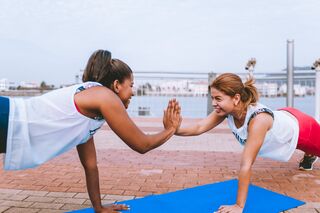Health
Proven Moves to Tone Your (Mental) Muscles for Summer
Five “workout moves” to buff up the health of your mind.
Posted May 20, 2020

Here’s one thing I don’t miss from our pre-COVID-19 world: Targeted ads promising ways to “banish belly fat for good” in time for “bikini season.” What is a “bikini body” anyway? I’m pretty sure it’s just any body wearing a bikini.
Here’s one thing I do appreciate in our current world: Instead of getting inundated with ads to change our bodies in time for summer, there’s a growing awareness of the need to care for our minds. A hyper-focus on “looking good” is so pre-2020. This season, as we forgo beach vacations for uncertainty, “feeling good” is the new black.
So here it is: A list of simple “workout moves” to buff up the health of your mind. Each “move” can be completed in minutes, requires no additional equipment, and has loads of research backing its effectiveness. You can choose a few to do in sequence, or try them one at a time. As always, take what works for you and leave the rest behind. The field of psychology is vast, and this list is by no means exhaustive.
1. Crunch towards your values (1+ minute)
Crunch, crunch, you can do it!
One thing people love about exercise classes is that an instructor guides us on what to do. When we encounter difficult moments in life, we don’t always have someone telling us whether we should go left or right. But we can develop and hone an internal North Star by becoming aware of our values. To practice turning towards our values, I recommend Russ Harris’s “Choice Point” activity. Here’s my very simplified version for how to use this to turn the next challenge you face into an opportunity for practice:
Notice what is happening inside, and recognize you have choices. On one side you can choose actions that will move you away from the kind of person you want to be. On the other side, you can choose actions that will move you towards the kind of person you want to be. Intentionally crunch in the “towards” direction a few times a week, or a few times a day. The goal is practice, not perfection.
Unlike physical exercises, this is one where you actually want to work one side more than the other.
2. Isometric attention hold (2+ minutes)
Mindfulness can reduce anxiety, and make us happier. And though it’s incredibly simple to practice, it’s not easy. Demonstrating just how hard it can be, a 2014 study led by Timothy Wilson at the University of Virginia, Charlottesville, found that many people would choose being electrically shocked over sitting alone with their thoughts.
Some clients who told me they really wanted to try mindfulness, but just couldn’t sit still, saw the practice in a new way when I compared it to isometric exercise like a plank. Just like in a plank, you may experience your mind and body wanting to get out of it. And you may shake side to side, or even slip out of it, but the regular redirecting is where you get stronger. Here’s a simple practice you can use to get started:
Sit in a comfortable position with your spine upright, either cross-legged or sitting in a chair with your feet flat on the ground. If it’s comfortable for you, close your eyes. Begin to tune in to the rhythm of your breath. You can choose to observe it as it rises and falls from your face to your belly; or as it flows over the space between your upper lip and nostrils. Wherever you choose, stay consistent, following the breath with your mind's eye and felt sense. When you get distracted, and this is natural, simply bring your attention back to the breath. Continue for one minute, two minutes, or more. (Note: Even if you get distracted 100 times, that’s OK. The benefits of the practice come from noticing, without judgment, and simply redirecting your attention, on purpose, again and again.)
3. Tap into your purpose (5 minutes)
Just like physical exercise, practicing purpose is good for the body and mind. Individuals with a strong sense of purpose tend to live longer, have healthier hearts, and are more psychologically resilient.
And just like physical trainers often remind people they don’t need to already be in shape to start working out, I’d like to remind you that you don’t need to have a profound sense of your life’s meaning to start practicing purpose. Though it may feel like a lofty concept, living with purpose doesn’t require big, Instagram-worthy actions, nor is it only accessible to those of us with a dream job that feels like a calling. Purpose can be felt in the simpler moments, which, when woven together, create a meaningful tapestry of a life worth living. Here's a simple way to start:
Similar to the way one might approach a gratitude list, take five minutes to jot down at least a few moments in your week that stood out (e.g., a positive conversation with a colleague or observing a beautiful sunset). You may find yourself with many more than you would have guessed.
4. Lift another human (5+ minutes)
I have such appreciation for the workout classes that require no special equipment, and instead, leverage our own body weight or common household objects like books or canned tomatoes.
What’s great about this mental move is that it doesn’t require another human to be in your home, it can be done from afar. Literally lifting another human could strengthen our biceps, but metaphorically lifting another human is a power move for the body (volunteering is associated with longevity and heart health) and mind. A neurological cousin of the “runner’s high,” doing something kind can lead to a “helper’s high”—what we feel upon the release of feel-good brain chemicals such as dopamine, serotonin, and endorphins.
Here’s one way to start:
Set a timer for two minutes. Brainstorm a list of simple ways you can help someone. At the end of the two minutes, circle one to three of the ideas that feel most doable and meaningful, and make a plan to do them this week. These could be as easy as sending a nice text to a friend, writing a LinkedIn testimonial, or offering to grab a few groceries for someone when you’re out anyway.
5. Build your home practice (10+ minutes)
Practicing mental fitness, just like physical fitness, is most effective when it’s done regularly. And success depends on having plans and habits in place. So as the final move in this special no-equipment, get-ready-for-summer workout, I recommend taking 10 minutes to reflect on your well-being non-negotiables. Try to keep this list down to practices that can be done in less than 30 minutes per day. Mine is this: 10 minutes of meditation, 20 minutes of any kind of physical exercise. I may choose to do more than this, but after decades of knowing myself, this is really the minimum dose of mental hygiene I need to live the life I want. There’s power in knowing your minimum daily dose.
I hope you enjoy these workout moves. And never miss the most important one: Don’t forget to breathe.




